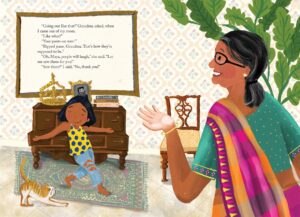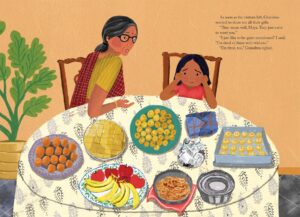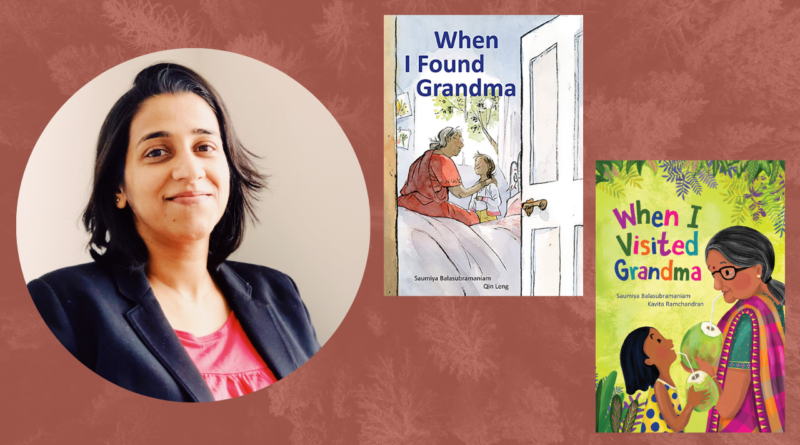Saumiya Balasubramaniam reunites Maya and Grandma in new picture book

In her newest picture book, When I Visited Grandma (Groundwood Books, 2024), Saumiya Balasubramaniam crafts a story that resonates deeply with personal experience and cultural richness. A proud Canadian author of Indian origin, Balasubramaniam espouses a unique aspiration: “I envision that all children in our world see themselves reflected in the literature of their times.”
In service of this goal, Balasubramaniam’s journey into writing children’s literature is as textured as the stories she weaves. “My curiosity about cultural and intergenerational differences among family members sparked from observing interactions between my young daughter, growing up in Canada, and my mother visiting from India,” she reveals. This curiosity first blossomed into her acclaimed and multi award-winning book When I Found Grandma. The subject’s emotional depth and resonance with readers have now led her to go deeper in When I Visited Grandma. “I felt like these characters were alive in my head, and they implored me to pay attention to their evolving relationship,” she shares.
Both books explore the special bond between Maya and her Indian grandmother, who comes to Canada to visit Maya’s family in When I Found Grandma. When I Visited Grandma originated from Balasubramaniam’s interest in exploring what happens when the geographies are reversed: “In When I Visited Grandma, Maya looks forward to her vacation in India, eager to spend time with her Grandma. However, her expectations are disrupted by a trip to a bustling, sweltering market, and the frequent interruptions from Grandma’s inquisitive and opinionated neighbors.” The narrative shifts dramatically when Maya wakes up one quiet morning to discover that her Grandma has suffered a heart attack and is now in the ICU.

When I Visited Grandma poignantly explores the dynamics of cross-cultural and intergenerational bonds — and the strength of love to transcend distance. A huge part of this is the illustrative magic of Kavita Ramchandran: “Kavita’s illustrations uplift the text and bring out details that are assumed, but sometimes not explicitly stated,” Balasubramaniam explains. “These emulate the setting, in a way that words cannot. At some places , the illustrations completely emote a scene of action and emotion. For instance, the last spread where Maya has opened the sweet box, and is actually enjoying the sweets.” From the steam emanating from a stainless steel tumbler of filtered coffee to the vibrant market scenes and dual language sign boards, Ramchandran’s lively illustrations enfold Balasubramaniam’s words in a visual and sensory subtext that deepens the reading experience.
To infuse her stories with authenticity. Balasubramaniam draws unabashedly from her personal life: “A good part of my personal connection with my family is in my work,” she grants. The books reflect the nuanced dynamics of her family relationships, cultural festivities, and everyday conversations, and she is passionate about embedding within her narratives a message of respect and understanding across differences – a lesson also gleaned from her own life.
Thinking back to her childhood in India in the 1980s and 1990s, Balasubramaniam shares that her favorite authors included Ruskin Bond and R.K. Narayan. She also prized Enid Blyton’s classics, especially The Famous Five and Malory Towers. However, she was keenly aware of one critical gap: “I never saw myself reflected in the books that I read in my childhood.” This dearth of representation in her formative years shaped her ambition and commitment to create literature that mirrors the diversity of readers today.

One question the talented Balasubramaniam seeks to answer is, “Why do I write for children?” And the answer again reflects her primary ethos: “I write for children because it is important that all children see themselves – or at least relate to — the stories they read.” In this light, Balasubramaniam’s stories are not mere tales. They are bridges connecting young readers to the diverse and changing world around them — like Maya and her family travelling to India.
In When I Visited Grandma, Balasubramaniam has crafted a moving story that reflects the tapestry of life and – she sincerely hopes – allows every child to find at least a piece of themselves within its pages.
© Arpita Ghosal, SesayArts Magazine, 2024
About The Author
Arpita Ghosal
Arpita Ghosal is a Toronto-based arts writer. She founded Sesaya in 2004 and SesayArts Magazine in 2012.
Visit About Us > Meet the Team to read Arpita’s full bio …




